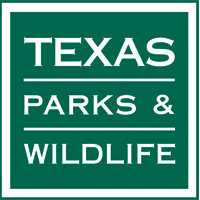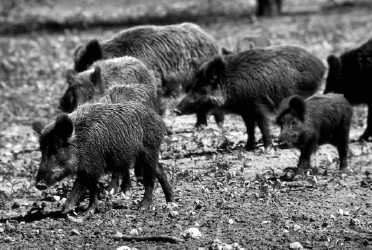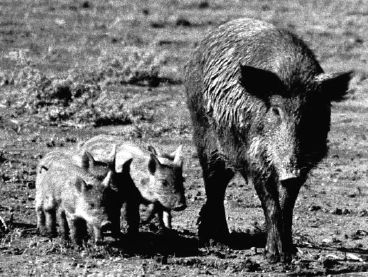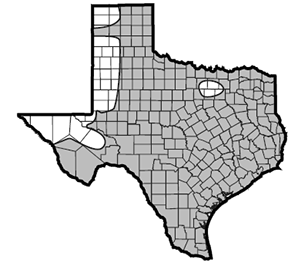






The Feral Hog in Texas
Texas Parks and Wildlife - By Rick Taylor
Feral hogs (Sus scrofa) are an old world species belonging to the family Suidae, and in Texas include European wild hogs, feral hogs, and European-feral crossbreeds. Feral hogs are domestic hogs that either escaped or were released for hunting purposes. With each generation, the hog’s domestic characteristics diminish and they develop the traits needed for survival in the wild.
Introduction
Early Spanish explorers probably were the first to introduce hogs in Texas over 300 years ago. As colonization increased, hog numbers subsequently increased. They provided an important source of cured meat and lard for settlers.
During the fight for Texas independence as people fled for safety into the United States or Mexico, many hogs escaped or were released. It was not until the mid 1800s when hostilities between the United States and Mexico ended that settlers once again began bringing livestock back into Texas. The livestock included hogs that ranged freely. Many escaped, contributing to the feral population.
In the 1930s, European wild hogs, "Russian boars," were first imported and introduced into Texas by ranchers and sportsmen for sport hunting. Most of these eventually escaped from game ranches and began free ranging and breeding with feral hogs. Because of this crossbreeding, there are very few, if any, true European hogs remaining in Texas.
Distribution
Feral hogs are distributed throughout much of Texas, generally inhabiting the white-tailed deer range, with the highest population densities occurring in East, South and Central Texas. North and West Texas have very low or no populations. However, reports indicate that populations are beginning to expand and increase in these areas. There is currently an estimated population in excess of 1.5 million feral hogs in Texas.
The increase in population and distribution is due in part to intentional releases, improved habitat, increased wildlife management, and improved animal husbandry such as disease eradication, limited natural predators, and high reproductive potential. There seem to be very few inhibiting factors to curtail this population growth and distribution although extreme arid conditions may impede it.
Reproduction
Feral hogs are capable of breeding at six months of age but eight to ten months is normal, provided there is good nutrition. Under poor habitat conditions, sows have been known to eat their young. Gestation is around 115 days with an average litter size of four to six, but under good conditions may have ten to twelve young. While capable of producing two litters per year, research has shown the majority of sows have only one per year. Young may be born throughout the year with peak production in the early spring. The young are born with a 1:1 male to female sex ratio. Feral hogs generally travel in family groups called sounders, comprised normally of two sows and their young. Mature boars are usually solitary, only joining a herd to breed.
Feral hogs are unprotected, exotic, non-game animals. Therefore, they may be taken by any means or methods at any time of year. There are no seasons or bag limits, however a hunting license and landowner permission are required to hunt them.
Description
Feral hogs may appear basically the same as domestic hogs and will vary in color and coat pattern. A mature feral hog may reach a shoulder height of 36 inches and weigh from 100 to over 400 pounds. The extreme larger hogs are generally not far removed from domestication. Males are generally larger than females. European wild hogs are about the same size; however, their legs and snouts are usually longer and they have a larger head in proportion to the body. Their body is covered with long, stiff, grizzled colored hairs, long side whiskers, a longer straighter tail, and a nape on the neck giving the European hog a razorback, sloped appearance. The crossing of European and feral hogs often produces an offspring with some European characteristics. Feral hogs are more muscular than domestic hogs, and have very little fat.
Additionally, the hairs of European appearing hogs and their hybrids frequently have multiple split ends. The young are born a reddish color with black longitudinal stripes. As they mature, the coat color becomes predominantly dark brown or black.
Hogs have four continuously growing tusks (two on top, two on bottom) and their contact causes a continuous sharpening of the lower tusks. They have relatively poor eyesight but have keen senses of hearing and smell.



What do feral hogs eat?
Feral hogs are omnivorous, meaning they eat both plant and animal matter. They are very opportunistic feeders and much of their diet is based on seasonal availability. Foods include grasses, forbs, roots and tubers, browse, mast (acorns), fruits, bulbs and mushrooms. Animal matter includes invertebrates (insects, snails, earthworms, etc.), reptiles, amphibians, and carrion (dead animals), as well as live mammals and birds if given the opportunity. Feral hogs are especially fond of acorns and domestic agricultural crops such as corn, milo, rice, wheat, soybeans, peanuts, potatoes, watermelons and cantaloupe. Feral hogs feed primarily at night and during twilight hours, but will also feed during daylight in cold or wet weather.
Where do feral hogs live?
Feral hogs are found in a variety of habitats from moist pine forests in East Texas to the brush country of South Texas. They prefer bottomlands such as rivers, creeks, and drainages when available. Hogs are generally found in dense vegetation cover often associated with water, but also do well in drought prone environments. During hot weather, feral hogs enjoy wallowing in wet, muddy areas and are never far from dense protective cover. They will concentrate in areas of food availability, especially where there are nut producing trees or agricultural crops.
Their home range is based mainly on food availability and cover. It is usually less than 5,000 acres, but can range up to 70,000 acres. In general, boars have a larger home range and will also travel greater distances.
Will they harm livestock or wildlife?
Feral hogs compete directly with livestock as well as game and nongame wildlife species for food. However, the main damage caused to livestock and wildlife is indirect destruction of habitat and agriculture commodities. Rooting and trampling activity for food can damage agricultural crops, fields, and livestock feeding and watering facilities. Often wildlife feeders are damaged or destroyed. They also destabilize wetland areas, springs, creeks and tanks by excessive rooting and wallowing. In addition to habitat destruction and alteration, hogs can destroy forestry plantings and damage trees. While not active predators, wild hogs may prey on fawns, young lambs, and kid goats. If the opportunity arises, they may also destroy and consume eggs of ground nesting birds, such as turkeys and quail.
How long do hogs live?
The average life expectancy, under good conditions, in a wild hog population is about four to five years; however, they may live up to eight years.
What about feral hog mortality?
Mortality in feral hog populations is greatest in the young less than three months of age, mainly due to accident, starvation and predation. Adult mortality is largely due to hunting, parasites, disease and tooth deterioration. Predation by mountain lions, coyotes and bobcats is only a minor limiting factor.
Do feral hogs carry disease?
In general, diseases from wild hogs do not pose a significant threat to humans; however, some diseases can be transmitted to livestock and wildlife. It is important to keep all livestock vaccinated, especially where large feral hog populations are concentrated.
Various diseases of wild hogs include pseudorabies, swine brucellosis, tuberculosis, bubonic plague, tularemia, hog cholera, foot and mouth disease, and anthrax. Internal parasites include kidney worms, stomach worms, round worms and whipworms. Liver flukes and trichinosis are also found in hogs. External parasites include dog ticks, fleas and hog lice.
What is pseudorabies and swine brucellosis?
Pseudorabies, also known as "mad itch" is a swine herpes virus that may affect the respiratory, nervous and reproductive systems. Despite its name, it is not a rabies type disease but derives its name from the symptoms similar to a rabid animal. It is transmitted primarily through breeding but may also to be transmitted through respiratory secretions of the infected animal. Infected adult swine typically develop flu-like symptoms whereas young pigs can have severe respiratory and digestive symptoms and ultimately die. Pseudorabies poses no threat to humans but may be fatal to domestic livestock and pets.
Swine Brucellosis is an infectious, bacterial, reproductive disease that can cause miscarriage, low conception rates, and other problems. It is transmittable to humans, known as undulant fever, and causes flu-like symptoms such as fever, chills, aches and pains. It is treatable with specific antibiotics.
How do I keep from contracting diseases?
Texas Parks and Wildlife Department recommends all hunters use disposable plastic or rubber gloves when field dressing or cleaning wild swine. Bury or burn the gloves and entrails and then wash your hands with soap and hot water. And finally, make sure the meat is thoroughly cooked.
Is the meat good to eat?
Yes, meat from feral hogs is extremely tasty and much leaner than penraised pork. The meat from older boars may be tougher and rank tasting if not prepared adequately. As with all pork, care should be taken and the meat well cooked. Otherwise, it should be prepared just like market hogs. The slower the meat is cooked, the more tender and tasty it becomes.
What is the difference between a hog and a javelina?
Although somewhat similar in appearance and habits, feral hogs and javelinas are not related. While feral hogs are indeed true pigs, javelinas belong to a totally separate family of mammals. Javelinas are smaller, have an unnoticeable tail, only one dew claw on the hind foot, a scent gland near the base of the tail, a grizzled-grayish coat with a white band of hair around the shoulder or "collar," and are more social or herd-like animals. Although feral hogs and javelinas inhabit the same range in South and Central Texas, they are not compatible.
What is a hog shield that I hear about?
Feral hogs are equipped with a tough shoulder hide, which is made of a tough scar tissue. This is formed through continuous fighting and it hardens as the animal ages and survives more fights.
What are feral hog signs?
Because feral hogs are largely nocturnal, the visible signs they leave behind are often all there is to indicate their presence. These signs include wallowing, rooting, rubs, crossings, trails and scat (droppings). Wallows are found in muddy areas and are made where hogs root and roll in the mud. They do this to cool off and also the mud protects their skin from the sun and insects. Rubs are then made when hogs scratch or rub themselves on tree trunks, telephone poles, fence posts, and rocks leaving a noticeable sign with mud and hair often left clinging. The height of the rub often indicates the size of the hog.
Rooting is easily recognized because it looks as if the soil has been plowed. Most often rooting takes place over a large area. Some rooting holes can be as much as three feet deep, which possibly could cause vehicle damage. A hog track is similar to a deer track except the toes are more rounded and wider in comparison to length. Hog hair is easily distinguished from other mammals and may be found at fence crossings and rubs. Scat appears very much like that of a small calf, being dropped in several small piles, which is very distinct from deer pellets or predator cord-like droppings.
Are feral hogs dangerous?
All wild animals have the potential of being dangerous, especially when wounded or cornered. In a natural state, feral hogs will prefer to run and escape danger, and are not considered dangerous. Extreme caution should be maintained when tracking wounded animals, trapping animals or encountering females with young. Their razor sharp tusks combined with their lightning speed can cause serious injury.
How do I hunt feral hogs?
Although feral hogs are not classified as game animals, a hunting license is required to hunt them. Feral hogs are very intelligent and considered to be challenging quarry. Many hunters consider the long tusks and mean appearance a genuine trophy, in addition to the quality of meat. They also provide a great off-season challenge and opportunities to hone hunting skills and spend time in the field.
There are many hunting techniques used, including stand hunting over a baited area, quite often incidental to white-tailed deer hunting. Stalking or still hunting over baited areas and areas indicating recent hog activity, such as wallows, are commonly used techniques. Corn or milo, often soaked in water and allowed to sour and then buried underground is good bait.
Night hunting with a spotlight is often used; however, the local game warden must be notified beforehand. (There are certain laws which prohibit using artificial light where deer are known to range.) Hunting with well-trained dogs is another hunting method utilized and can be very exciting. Because the feral hog has such a tough hide the best rifle calibers to use should be a .243 or greater to prevent wounding and loss of the animal. Bowhunting, muzzleloading, and handguns are also popular among sportsmen to hunt feral hogs.
Additional control methods?
Trapping is a common method utilized by sportsmen and landowners. Live trapping enables the individual to harvest the animal, fatten it up, or sell it. It also allows numerous individuals to be caught at once without an active participant. Several types and designs of live traps can be utilized. The most common design is a 4 foot by 8 foot heavy duty cage with a spring door, root door (see diagram, p. 19), or drop door. Snares can also be used effectively when placed under fences in travelways that surround active areas; however nontarget animals may also be captured. In some areas of Texas, aerial gunning from a helicopter is an efficient technique. There are currently no birth control, toxicants or repellents registered for the control of feral hogs.
Can I wipe out a hog population through hunting or trapping?
The feral hog has managed to survive, adapt, and increase their numbers despite attempts at population control. While it is possible to keep the population in check with continuous control, it is highly unlikely to eradicate a hog population within an established range.
Should I stock feral hogs?
No, feral hogs are prolific breeders and can cause considerable damage. They can destroy habitat, and compete directly or indirectly with all other species of wildlife. While many hunters might like hogs as part of the lease, the adverse effects often counter any potential economic incentives. TPWD considers feral hogs nuisance animals and does not support the introduction of feral hogs. Feral hogs are considered an under-utilized resource on many Texas ranges.
The Texas Animal Health Commission has enacted regulations requiring all feral hogs in Texas to be tested and certified to be disease free before being released into the wild for whatever purposes. They may however, be legally transported to slaughter or livestock sale for slaughter. If stocking is desired, only castrated males (barrows) should be considered. Because they cannot reproduce, they will grow larger, fatter and often produce larger tusks.
How to Build a Better Hog Trap
by: Jeffrey Parrish and Rick Taylor
Trapping is a popular technique for controlling feral hog populations and obtaining good meat. Hog traps that have been used by Texas Parks and Wildlife Department to assist in the collection of hogs for study and research are the spring door and root door traps. They are considered "live" traps because no harm is done to the animal once trapped inside. This trap is lightweight for easy transportation and placement, yet strong enough to prevent even the stoutest hog from escaping.
The advantage of "Spring door (side-hinged)" and "Root door (hinged on top)" traps enables more than one hog to be trapped at a time. It is not uncommon for as many as ten hogs to be caught simultaneously. The first hog caught may act as a lure to trap additional hogs. The design of the door prevents the captured hogs from exiting the way they entered.
To Set The Trap
Before setting the trap, scout the area and try to locate fresh hog signs. Pre-baiting of an area at least a week in advance will help in getting the hogs to return to the area in which the trap is to be set. Set the trap on flat ground and wire the door open. Bait the inside of the trap, leaving a small trail of bait through the door to the outside of the trap to lure the hog inside. It helps to leave bait outside the trap to get the hog comfortable with feeding in and around the trap.
Leave the door wired open for several days so the hogs will get used to entering the trap for the bait. After it is apparent that hogs have been entering the trap, set the door open by placing a prop (stick, piece of wood, etc.) between the door and trap side or ground if a root door. Tie a piece of rope to the prop, stringing the rope loosely through the top of the cage, and let the remainder of the rope hang down into the cage. At this end of the rope, a bucket of soured corn or other type bait can be tied to complete the trap set.
As the hog enters the cage and starts feeding out of the bucket, the attached rope will pull the prop from between the spring door and the door jamb causing the trap door to close (if the hog hadn’t already knocked the prop loose). A trapped hog may entice additional hogs to enter by pushing through the closed spring or root door.
Tips
In some cases deer and other wildlife have been trapped inside hog traps. In the event you capture an unwanted guest, follow these steps for a safe release.
- As quickly and quietly as possible approach the trap and secure the trap door fully open and leave immediately. A captured animal can inflict injury to itself out of fright and confusion trying to escape. After the unwanted animal has left, return to the trap and reset it.
- Try to keep dogs and human activity from near the trap or the trap site. A hog has an acute sense of smell and if it notices unfamiliar scents an unsuccessful trap may result.
- Hogs feed mostly at night, so it is best to check the trap first thing each morning. A trap left unattended for a day or two may result in finding a dead hog in your trap.
- Be careful when handling the cage with trapped hogs inside. A captured hog is a dangerous animal and can attack you through the panel wire.
- Prebaiting is extremely important. Remember to prebait with generous amounts of bait on a daily basis and give the hogs several days of entering and exiting the trap prior to setting it. The length of prebaiting time allowed increases success. Be patient and consistent and good luck.
Hog Trap Specifications
Materials: Frame: 3/8" or 1/4" steel rod or rebar.
Mesh: 4" Cattle Panel - galvanized.
Heavy duty galvanized spring for swing door.


Weld all parts of frame to ensure strength and durability. After frame is constructed, tack weld cattle panels to frame on all sides, including bottom, to prevent hog from digging out. Take care not to leave any pointed ends of the cut panel sticking out.
Construct spring or root door separately and install so that opening in front operates as illustrated. The doors should be mounted on one side of the front panel and need to be at least 20-24" wide and 18-24" tall. For the spring doors, place a full length of 1/4" rod just inside the side of the trap side to act as a stop (as illustrated). Take care to measure accurately during construction so that spring door when closed will hit trap side stop. Using a heavy-duty spring available at most hardware stores), place one end on the spring door and one end to the front of the cage at the top. Cut the spring to fit so that it allows the spring door to slam shut securely. Do not use excessive tension on the spring that may prevent smaller hogs from entering. For root doors, the ground acts as the doorstop. The root door is hinged from the top and should be longer than the opening so it hits the ground inside the trap at about a 60- degree angle. A heavy piece of angle iron should be used as the bottom of the root door to make sure it stays on the ground but not too heavy to prevent smaller pigs from lifting it with their snout. An angled piece of panel should be placed on the inside side to cover the hole that is left from the angled door while the side of the trap covers the other hole.


























